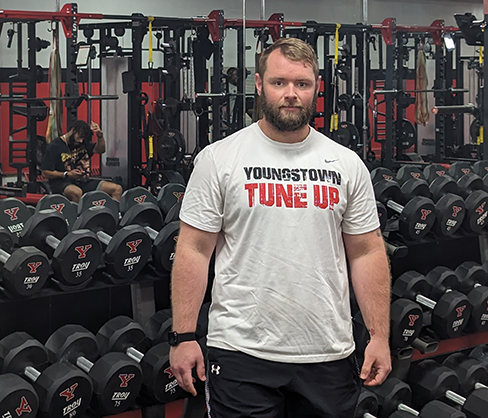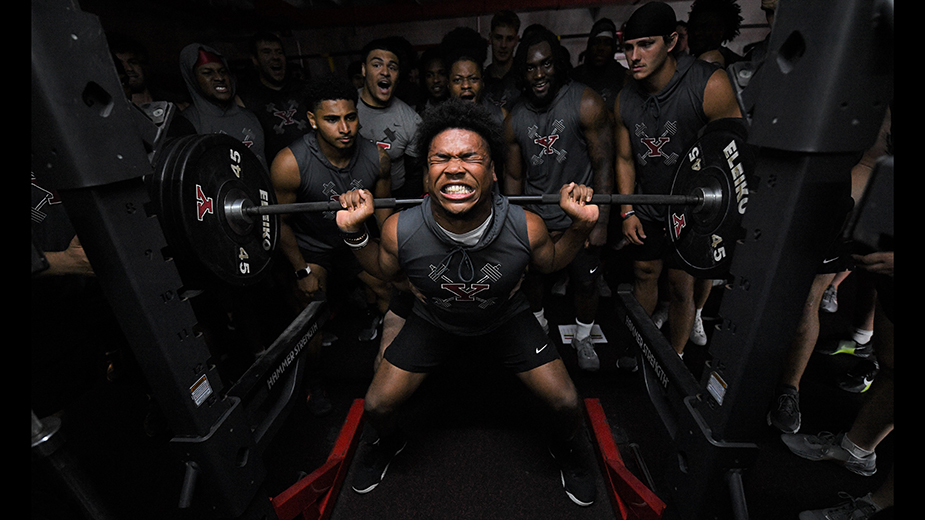By John Vargo
YOUNGSTOWN, Ohio – In the competitive realm of college football, the difference between victory and defeat often hinges on more than just talent and strategy. Behind the scenes, an intricate and meticulously designed strength and conditioning program plays a pivotal role in sculpting the athletes who dominate the gridiron.
Youngstown State University’s director of football sports performance, Jimmy Rodenberg, meets those tenets in building bigger, faster and stronger athletes for the football team, which begins the 2023 season Aug. 31.
Optimizing student-athlete performance requires more than just weight-lifting techniques. Focus is put on specific team positions and the relationships these athletes have with the training staff.

Rodenberg, who was part of the University of Cincinnati football staff on a Bearcats’ team that was in the college football playoffs in the 2021 season and graduated from The Ohio State University in 2017, is well aware of how to construct a winning culture.
He emphasizes constant motion during his training sessions to emulate the quickness on the field of play.
“We need to train them for a purpose and that’s to be gladiators on Saturday when they go out in the arena,” Rodenberg says.
YSU Head Football Coach Doug Phillips cites a 6-foot-6, 230-pound Desmeal Leigh from Kent, who came to football camp in 2022 at 275 pounds. Linemen his size at schools like Ohio State and Alabama weigh at least 300 pounds. Leigh is now 6-7 and 310 pounds and took every snap at left tackle this past spring season.
“We thought it would take two years for a young man like that to put on the weight, to put on the strength,” Phillips says. “To know that we have a program that can do that in 12 months is phenomenal.”
YSU senior quarterback Mitch Davidson faces a muscular, faster defensive line every practice, testing his skill set. He has equal parts protection from his offensive line, which is seeing the same results from a stringent offseason of conditioning.
Davidson and his teammates have ingrained those techniques in their own strength programs through constant competition, declaring a decisive winner and loser through the guidance of Rodenberg and his staff.
Winning in the weight room drives Davidson, who was a nonscholarship player starting in 2018.
“It’s a night and day difference from where we used to be to where we are now,” he says. “I hated the weight room my first couple years here. I knew if I wanted to play, I had to fall in love with the weight room.”
Velocity-based training is a method of measuring and prescribing strength training. By measuring movement speed, it introduces a unit of measurement that gives both student-athletes and coaches objective data and immediate feedback. At YSU, trainers use a system in which a tether is attached to the barbell to indicate the movement velocity.
Mary Beth George, assistant athletic director for sports performance at YSU, says velocity-based training is a way to manage an athlete’s training load within the weight room. It is used to guide training to achieve different attributes, such as strength or power.
“If, for example, an athlete has 225 pounds on the bar and we need the athlete to move between .75 and 1.0 meters per second to work strength speed and that athlete moves that bar at 1.5 meters per second, more weight should be added,” she said. “Moving at .6 meters per second, the heaviness needs to be lightened.
“So, if they are within that velocity range, that dictates that they have the correct amount of load on that bar for each individual athlete.”
Modern college football strength and conditioning programs are built on a foundation of scientific principles, merging advancements in exercise physiology, nutrition and biomechanics. These programs are not just about packing on muscle; they are finely tuned systems that seek to optimize athletic performance, prevent injuries, and enhance well-being.
George highlights the need to minimize the risk of injury to student-athletes, not just in football, but for all of the 21 NCAA Division sports on campus.
Each coach tailors their program depending on its needs.
Programming for athletes depends on their sport and position, prior injury history and physiological demands. Exercises are varied in volume and intensity, to make sure muscles are adapting to the stimulus given.
Periodization, a cornerstone of these programs, involves strategically varying training intensity, volume and focus throughout the year.
Once the summer session starts, training is about preventing injuries – ACL (anterior cruciate ligament), shoulder and concussion – by working the neck, rotator cuff and doing a host of plyometrics, landings, mechanics and jumps.
“We know that we’re putting the athletes in a safer atmosphere,” Rodenberg says.
Behind every formidable athlete is a well-crafted nutrition plan that fuels workouts and recovery. At YSU, student-athletes have a post-lift recovery shake and have meals planned throughout the week, along with hot- and cold-tub therapy and pulse technology that uses compressed air to massage limbs and speed recovery.
“Your body is like a car,” Rodenberg says. “When your car runs out of gas, you have to get more gas in it. We’re going to do the same thing.”
YSU senior running back Dra Rushton says the strength and conditioning staff has transformed the team into a formidable opponent.
“The coaches in the weight room are the reason we can perform the way we do,” he says. “They have elevated not only our team but our culture in many ways.”
Pictured at top: Tailback Caleb Mitchell does a squat at preseason training. Photo: YSU Athletics.
